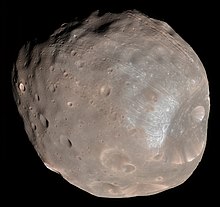
Martian Moons Exploration
The Martian Moons Exploration ( MMX ) is a robotic space probe set for launch in 2024 to bring back the first samples from Mars' largest moon Phobos . [1] [3] Developed by the Japanese Aerospace Exploration Agency (JAXA) and announced in 9 June 2015, MMX will land and collect samples from Phobos once or twice, along with conducting Deimos flyby observations and monitoring Mars' climate. [4] [5]
Page Revisions
| Year | Metadata | Sections | Top Words | First Paragraph |
| 2018 |
111706 characters 6 sections 9 paragraphs 7 images 490 internal links 17 external links |
mmx 0.263 phobos 0.248 cnes 0.232 2029 0.176 deimos 0.171 sample 0.161 japanese 0.160 will 0.159 aims 0.138 arriving 0.138 2024 0.132 eyeglasses 0.127 ggm 0.127 gradiometer 0.127 kawakatsu 0.127 |
The Martian Moons Exploration ( MMX ) is a robotic space probe set for launch in 2024 to bring back the first samples from Mars' largest moon Phobos . [1] [3] Developed by the Japanese Aerospace Exploration Agency (JAXA) and announced in 9 June 2015, MMX will land and collect samples from Phobos once or twice, along with conducting Deimos flyby observations and monitoring Mars' climate. [4] [5] |
|
| 2017 |
88986 characters 6 sections 8 paragraphs 7 images 348 internal links 16 external links |
mmx 0.277 phobos 0.261 cnes 0.245 will 0.188 2029 0.185 deimos 0.180 sample 0.170 aims 0.145 arriving 0.145 2024 0.139 kawakatsu 0.134 megane 0.134 puff 0.134 yasuhiro 0.134 samples 0.134 |
The Martian Moons Exploration ( MMX ) is a robotic space probe set for launch in 2024 to bring back the first samples from Mars' largest moon Phobos . [1] [3] Developed by the Japanese Aerospace Exploration Agency (JAXA) and announced in 9 June 2015, MMX will land and collect samples from Phobos once or twice, along with conducting Deimos flyby observations and monitoring Mars' climate. [4] [5] |